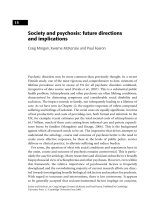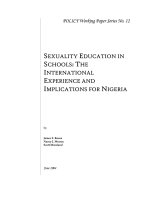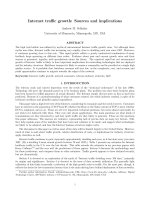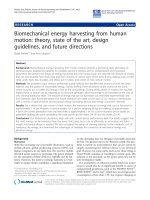Society and psychosis - future directions and implications
Bạn đang xem bản rút gọn của tài liệu. Xem và tải ngay bản đầy đủ của tài liệu tại đây (93.91 KB, 14 trang )
15
Society and psychosis: future directions
and implications
Craig Morgan, Kwame McKenzie and Paul Fearon
Psychotic disorders may be more common than previously thought. In a recent
Finnish study, one of the most rigorous and comprehensive to date, estimates of
lifetime prevalence were in excess of 3% for all psychotic disorders combined,
irrespective of data source used (Perala et al., 2007). This is a substantial public
health problem. Schizophrenia and other psychoses are often lifelong conditions,
characterised by distressing symptoms and considerable social disability and
exclusion. The impact extends to family, not infrequently leading to a lifetime of
care. As we have seen in Chapter 12, the negative responses of others compound
suffering and feelings of isolation. The social costs are equally significant, in terms
of lost productivity and costs of providing care, both formal and informal. In the
UK, for example, recent estimates put the total societal costs of schizophrenia at
£6.7 billion, much of these costs arising from informal care and private expendi-
tures borne by families (Mangalore and Knapp, 2006). This is the background
against which all research needs to be set. The imperative that drives attempts to
understand the aetiology, course and outcome of psychosis better is the need to
create more effective responses, be these at the levels of public policy, service
delivery or clinical practice, to alleviate suffering and reduce burden.
For some, the question of what role social conditions and experiences have in
the onset, course and outcome of psychosis remains controversial. This is partic-
ularly the case for aetiology. Many researchers and clinicians subscribe to a broadly
biopsychosocial view of schizophrenia and other psychoses. However, even within
this framework, the relative importance of psychosocial factors is frequently
downplayed and the overwhelming majority of current research efforts are direc-
ted towards investigating broadly biological risk factors and markers for psychosis.
With regard to outcomes and interventions, there is less controversy. It appears
to be generally accepted that socioenvironmental factors impinge on outcome,
Society and Psychosis, ed. Craig Morgan, Kwame McKenzie and Paul Fearon. Published by Cambridge
University Press. # Cambridge University Press 2008.
and that interventions designed to modify aspects of the social environment (e.g.,
family interactions, employment) can lead to improvements in quality of life and
symptoms (see Chapter 11). Despite this, clinical research remains dominated by
studies of antipsychotic medications.
We started Society and Psychosis by asserting that psychiatry had rediscovered its
roots. The chapters in this book demonstrate just how deep these roots are.
Together they suggest that society and psychosis may be more intricately linked
than the current balance of research and clinical priorities indicates. In this
concluding chapter, our aims are to provide an overview and summary of the
research presented in this book, to suggest directions and challenges for future
research and to discuss the implications of this research.
A conceptual framework
In attempting to understand the links between society and psychosis, there is a
need to develop conceptual tools that allow the complexities of the social world to
be studied. In Chapter 4, March and colleagues provide a framework in which
social factors are conceptualised as operating at many different levels (e.g., the
individual, the family, the neighbourhood) (see also Chapter 6) and over time and
space. The chapters focusing on aetiology have reviewed evidence relating to social
factors at one or more of these levels. While these findings are presented separately,
there is a need to draw them back into this overarching framework. This serves
as an important reminder that processes operating at different levels and time
points are connected and interact in the aetiology and course of psychosis. This
is illustrated in the research presented by Myin-Germeys and van Os (Chapter 9),
which suggests that early adversity may be linked to psychosis through ongoing
daily stress in adult life. As noted in a number of the chapters, there is also research
suggesting that individual risk of schizophrenia may be moderated by character-
istics of the wider social environment (e.g., Boydell et al., 2001).
The complexities are further emphasised in the distinction between processes
and conditions. The variables that we utilise in analyses are often ‘conditions’ (e.g.,
being a migrant) that are the product of social processes (e.g., the transition from
one cultural setting to another). Both conditions and processes are embodied and
influence a person’s health status; measuring and assessing the impact of social
processes as well as conditions is a central challenge for future research.
Individuals may encounter processes and conditions that increase risk of psy-
chosis throughout the life course. In many diseases there can be long latent periods
between the occurrence of risk increasing exposures (e.g., early disadvantage)
and onset of disease or disorder (e.g., heart disease) (see Brunner, 2000). These
exposures may operate by increasing susceptibility to disorder in the event of
239 Future directions and implications
exposure to subsequent risk factors later in the life course. This idea of an
accumulation of risk over time consequent on exposure to adverse environments
in childhood, adolescence and adulthood is a common framework for under-
standing the aetiology of a number of multifactorial diseases, such as heart disease
and diabetes, in the wider social epidemiology literature (see Berkman and
Kawachi, 2000).
There is a further dynamic. In evaluating what is currently known about specific
social processes and conditions associated with psychosis, it is useful to make a
distinction between risk indicators (i.e., factors that index risk but that do not in
themselves confer risk) and risk factors (i.e., factors involved in risk processes)
(Rutter, 2005). This is an important consideration. For example, Rutter (2005)
notes how in the 1970s it became apparent that the association between antisocial
behaviour and ‘broken homes’ was a function, not of family breakdown, but of
prior family discord and conflict. The current evidence, as will be seen below, may
well be stronger for social risk indicators than it is for social risk factors; this should
both temper the claims that can be made and further emphasise the need for
research that directly investigates potential risk-generating processes over time.
The framework for investigating the impact of society on psychosis, sketched
here and discussed more fully in Chapter 4, provides a means of synthesising
information and knowledge, and generating testable hypotheses for future
research. The question nonetheless remains of whether the research evidence on
specific social risk factors is sufficient to support the conclusion that such factors
are causally connected to psychosis.
Do social factors cause psychosis?
In 1965, Austin Bradford Hill (1965) proposed a series of criteria against which
causation could be judged (see Table 15.1). These have been widely used and
Table 15.1 Bradford Hill’s criteria for assessing causation
Temporality
Strength
Consistency
Dose–response gradient
Specificity
Biological (psychological) plausibility
Coherence
Experiment
Analogy
240 C. Morgan, K. McKenzie and P. Fearon
applied in epidemiology and other social sciences. Not all of the criteria are
equally relevant for all disorders. Van Reekum et al. (2001), for example, suggest
that temporal ordering, strength, consistency and biological (or psychological)
plausibility may be most relevant to neuropsychiatric disorders; specificity and
dose–response relationships were, interestingly, considered less central to estab-
lishing causation. Further, once complex models are produced in which social
factors interconnect at different levels and over time, these criteria do not neces-
sarily provide the basis for conclusive judgement. Several factors of relatively
small effect may combine over time to increase risk. Nonetheless, they do offer a
framework against which to evaluate the evidence that specific factors are causally
related to an outcome. These criteria, then, provide one means of assessing the
current evidence for a causal role of social factors in psychosis. The specific issue of
biological (or psychological) plausibility is one of increasing importance in this
field and will be addressed separately below.
Urbanicity
Perhaps the strongest and most consistent evidence relates to urbanicity. Almost
invariably, an increased risk for schizophrenia has been found for those who live in
cities (the condition); the risk is present from birth and appears to be related to
being brought up in a city (the process). Further, there is now relatively robust
evidence that the risk for schizophrenia increases in a dose–response fashion with
the number of years spent living in an urban centre. Urbanicity, then, appears to
meet many of Bradford Hill’s criteria – consistency, strength and temporal order-
ing of association, and evidence of a risk gradient. However, precisely what it is
about living in a city that increases risk is unclear. As Boydell and McKenzie (see
Chapter 6) note, it is perhaps most useful to consider urbanicity as a risk indicator,
indexing risks that coalesce in densely populated environments. Further, it is not
clear whether such risks are social; they may equally plausibly relate to the physical
environment. That said, innovative ecological level research utilising concepts
such as ethnic density and social capital is beginning to hint at specific social
risk factors that may be particularly evident in urban settings (see Chapter 6).
Disaggregating the urban environment, understanding its different facets and
working out how these interact will be a major but fruitful task for research
given that up to 30% of the population risk for schizophrenia may be accounted
for by urbanicity (Krabbendam and van Os, 2005).
Migration and ethnicity
There is now a substantial body of research demonstrating increased rates of
psychosis in migrant groups (see Chapter 10). These increased rates arise only
in the host country, i.e., post-migration, and are present in primary migrant
241 Future directions and implications
populations and in their children and subsequent generations. Further, Cantor-
Graae and Selten’s (2005) review suggests that there is a risk gradient for migrant
groups, with the risk being greatest for those from countries where the majority
population is black, and for those from ‘developing’ countries. So far, so good.
Migration and ethnicity appear to meet some of the criteria for causation –
consistency, strength and temporal ordering of association, and evidence of a
risk gradient. However, once again, what it is about being a migrant or member
of an ethnic minority group that increases risk is unclear.
The fields of migration and ethnicity have become linked. However, these
‘conditions’ may index distinct processes, and further information may be gleaned
by comparisons between those who have migrated and those who have not but
who have similar ethnicities, i.e., subsequent generations. Thus, it is necessary to
draw a distinction between the process of migration and migrant or ethnic
minority group status. In one sense, migrant and ethnic group statuses are risk
indicators in that they are social realities that index a series of social processes. In
terms of identifying the risk generating processes, research is beginning to provide
important clues in relation to ethnicity. For example, recent studies have impli-
cated discrimination, early adversity and population-level risks, including ethnic
density (see Chapter 10). However, much less work is currently being done about
the risk processes linked to migration.
Adversity across the life course
Consideration of factors operating in early childhood and family life as potential
contributory causes of psychosis is fraught with problems, not least because it
conjures memories of regrettable theories in which mothers were blamed for
causing schizophrenia. However, it is unfortunately true that many children are
exposed to various forms of adversity and trauma, ranging from parental neglect
and hostility to sexual and physical abuse (within and outside of the family). Such
early experiences have been linked with a wide range of negative childhood and
adult outcomes, including depression, anxiety, eating disorders and personality
disorders (see Chapter 7).
In relation to psychosis, there is a limited amount of robust research, and this
means that any conclusions have to be tentative. Nonetheless, the evidence is
suggestive of a link between early negative experiences and the risk of psychosis.
Certainly, in terms of strength and consistency of association, the evidence relating
to childhood trauma and family interactions is not yet as striking as that for
urbanicity and migration. However, the balance is increasingly in favour of an
association between these exposures and psychosis, and some of the more robust
studies have reported findings suggestive of a dose–response relationship, such
that the risk of experiencing psychosis or psychotic-like symptoms increases in line
242 C. Morgan, K. McKenzie and P. Fearon









